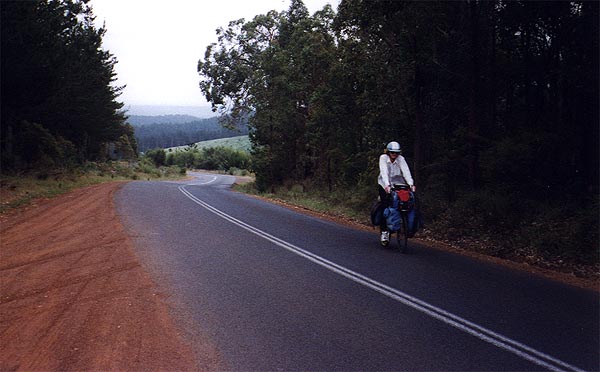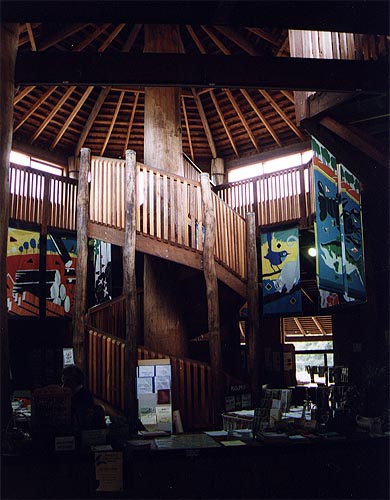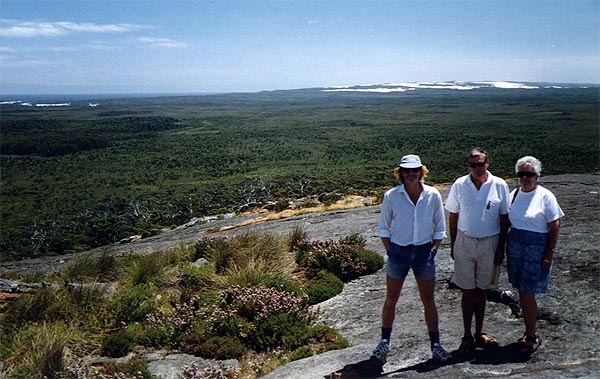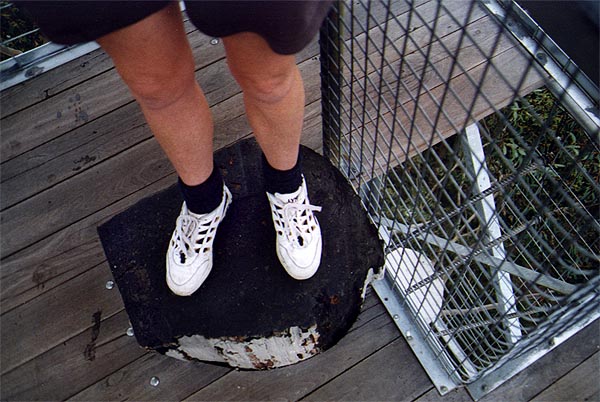|
Karen's sniffles cleared up during the afternoon at Nannup, but mine lingered on. After a couple of cryptic crosswords and another culinary masterpiece of two-minute noodles and vegetables, I sought the comfort and warmth of the tent early. Next morning I woke up as crook as a dog, with both nostrils clogged, my throat on fire, and my eyes glued together with dried mucus. I had to scrape a load of gunk off my eyelids before I could open my eyes. I was not a well boy.
Despite my condition, I gave absolutely no thought to staying in Nannup for the day. Today was the first Tuesday in November - Melbourne Cup day - the only day of the year I allow myself to have a bet, and Nannup did not have a TAB. We had to get to Bridgetown, a bit less than fifty kilometres away, before 12:20pm - Melbourne Cup time in the west after the two hour time difference and the lack of daylight saving were taken into account.
We left Nannup just before eight. A three kilometre hill a couple of kilometres out of town set the pattern for the rest of the day - heavy hills, Jarrah, Karri and pine forests, and some pasture as well. That first big hill was a good test for me. Luckily, my lack of good health did not seem to be affecting my cycling. I was not unfit - I was just sick.

The hill out of Nannup
At the top of the hill Karen and I noticed a name painted onto the side of a tree - "Stewart" - with an arrow pointing off the road to the right. As Stewart is Karen's maiden name, it caught our attention immediately. On the other side of the tree, however, was another painted name - "Peter". Peter Stewart is Karen's brother's name. We knew that Peter had been looking for land in the area, and wondered if the sign had been daubed for his benefit.
We had morning tea at a rest area in a Karri forest with only about twenty kilometres behind us, our average speed not quite good enough to get us to Bridgetown in time for the Cup. We were hoping for better terrain afterwards to get us to the TAB on time. A few long downhills took us back to the river and helped our average speed. We powered on over heaps of hills as we rode along the river, before a final climb to a ridge overlooking the town. Another long downhill and a railway crossing took us to the South-west Highway, and we crossed over the bridge into town with plenty of time to spare. A TAB sign was displayed prominently on the first pub we saw.
There was no rush to place a bet, so we visited the post office to hopefully collect our films. Not only had they not arrived at Bridgetown yet, they had not even arrived at Margaret River, so it seemed likely that they were lost in the post. Karen grudgingly got the people at Margaret River to change the town on the forwarding forms we had filled out from Bridgetown to Albany. Albany was at least a week away. If they had not shown up by then, they probably never would.
After the post office we went to the pub to place a bet, then to the Tourist Bureau to get some information, and then to a second hand bookshop for a browse. Just before race time we walked over to the main bar of the pub to watch my twenty dollars fly away, but not before I had had a good run for my money. I had chosen a trifecta in the cup, and two of my selections had finished first and second. My third selection had been involved in a three-way photo for third, but the camera had relegated my horse to fifth. Aaagh - so close!
With no money to spend on books now, we returned to the bookshop and swapped three old books for one new one - a good trade. Then it was out across the bridge which gives the town its name and into the caravan park. In the campers kitchen, over lunch, we spent a couple of hours talking to Norm and Jocelyn from Canberra, two cyclists doing a circuit around the south-west of Western Australia after leaving their car in Bunbury. Their bikes are foldaways, which can be stored inside plastic cases which double as trailers!
I was still sniffling and blowing my nose constantly, so Karen decided I needed some fresh air. What had I been getting all morning when we had been riding? She led me along the river, across the bridge, back along the other side of the river and across a little footbridge back to the caravan park. There was not much birdlife about, with the exception of families of feral ducks, complete with lots of cute yellow ducklings, plus one brown one. A native duck had obviously had some luck.
The fresh air did not help my condition. For the second morning in a row my eyelids were glued together when I awoke, even though I had cleared away as much muck as I could every time I woke up during the night. I felt reasonably okay in the morning, but when I went to the amenities block, the guy in the mirror looked bloody terrible! My eyes were bloodshot and puffy and watery, and my head was full of gunk that did not want to move out.
A few very light showers overnight had given way to a cloudy day with a solid south-easterly wind. Karen and I watched Norm and Jocelyn pack and pedal off, and we followed suit soon after. We rode through one brief, light sprinkle as we climbed a medium hill out of town, and followed undulations to Manjimup where we called in to the town's Tourist Information Bureau. It was a great building - a circular design with massive wooden supports and a central spiral staircase leading to a mezzanine. I fell in love with it instantly, deciding that my house would one day have the same design. I took a few photos and even drew a sketch in the back of my diary to help me remember the details of the layout.

The inside of the Information Bureau
Eight kilometres south of Manjimup we came to the Diamond Tree - a karri tree with a fire-tower built on top. There are three such trees open to the public in the south-west, and Karen and I were determined to climb them all. Our first look at the actual construction of the ladder to the top, however, had us thinking twice. Metal spikes a couple of metres long have been hammered into the tree at regular intervals to form a spiral staircase. There is also a framework of wire to support the spikes, giving the illusion of security, but a glance through the gaps beneath your feet reveal lots of air beneath you.
The Diamond Tree is the shortest of the three fire-towers, only fifty two metres high. Imagine climbing up the outside of a very thin, seventeen storey lighthouse on steps less than an inch wide and a couple of feet apart, and you will have some idea what the ascent is like. Karen and I climbed the tree with no problems, but while we had lunch afterwards it was interesting to watch the effect the climb had upon people. Some approached the tree in a very gung-ho fashion, obviously thinking it would be a doddle. A few metres of climbing later, they were petrified and would have to climb down backwards, very, very carefully.

Karen climbing the Diamond Tree
We took a backroad to Pemberton where we visited the information bureau and arranged a return train trip to Northcliffe for the next day and a tour of the timber mill for Friday. Karen even bought a local map for a dollar as she figured we would be in the area for a while. We ignored the directions of the caravan park management and camped in a powered site. The unpowered area had no tables or chairs and was on low, damp ground, mostly mud, and set among some very, very shady trees. It was much to dark and dreary to contemplate, especially in my condition.
Next morning I was no better. My throat was still sore, my head still full of gunk, and my eyelids were again glued shut. When I finally prised them apart, Karen took one look at me and said "conjunctivitis" - I could not disagree. Still, we had a tour to do so I took a couple of aspirins, then a couple more, and chewed another four during the day.
The tram was open, with a cool breeze blowing through the carriage for the entire two and a half hour trip to Northcliffe - just what I needed in my condition. Our driver, Sheena, was a real enthusiast, and all day long gave us a description of every flower, shrub and tree we passed. She also supplied us with all the usual tram, tramline and historical facts you would normally expect on a tour of this kind. We made brief stops at the Cascades and the Twin Karri trees, but most of the time the tram rumbled along at twenty to thirty five kilometres per hour, slowing at every bridge - seven of them - for safety reasons, and so we could look for marron and trout in the water below.

Aboard the tram to Northcliffe
Early in the tour Karen thought she recognised a bloke sitting adjacent to us, so when we stopped at the Cascades she asked him if he had ever worked for Coca-Cola Amatil. He told us he had worked there for years, and introduced himself and his wife. Noel had retired in January, and he and his wife Denise had sold their home, bought a caravan and begun touring around Australia for a year. They planned to settle on or near Bribie Island in Queensland. We would have a lot of contact with Noel and Denise in the weeks ahead.
At Northcliffe we lunched on pies and chips at the "Hollow Butt Café" - a great name - and fought off lots of flies as we waited for the tram to resume the return journey. Two carriages were coupled together for the trip back up to Pemberton, with twenty five additional bus tourists added to the dozen originals who had ventured down. The tour was not a "must", but it was a pleasant diversion from our normal mode of travel.
After our return to Pemberton, we shopped and were then invited by Noel and Denise to happy hour at their site. We shared white wine, bikkies and dips, and a much appreciated open fire. With the onset of dusk we returned to our tent, started a good fire of our own and had a dinner of stir fried veggies and chick peas, with me coughing almost uncontrollably as the evening progressed.

Happy hour
By the morning the symptoms of my illness were even more pronounced. My eyes had turned a demonic red, made worse by a half blood-filled left inner eye, probably due to a burst blood vessel when blowing my nose. I got up early to get my eyes unstuck and to blow kilos of gunk out of my head. With my vision shaking with each step I took, I decided it was time to get some professional advice, just to make sure I was not coming down with Ross River fever or Murray Valley encephalitis. I told Karen that I felt okay but could not believe how lousy I looked. Karen said it was good that I felt okay, because she was used to me looking lousy.
We had booked a tour of the Pemberton Timber Mill for the morning, so we called in to a doctor on the way to make an appointment. The receptionist took one look at me and rearranged the doctor's early afternoon schedule, booking me in for 12:15pm.
Karen and I discovered that Noel and Denise were doing the mill tour as well, and we spoke with them while waiting for the tour to begin. After a short video, our female guide gave us a small talk and supplied us with earplugs before we entered the mill to watch a highly automated processing line transform logs of both large and small diameters into timber of a variety of lengths and breadths. It was actually quite impressive.
Once outside the mill we were loaded onto a bus for an hour and a half tour of the tree plantations, with a look at recently clearfelled areas, and young and old re-growth forests. We were constantly subjected to some subtle and not so subtle forestry propaganda and lots of disparaging remarks about "greenies". When our guide said that forestry had been proven to be totally environmental and completely self-sustaining, I questioned her logic.
"If the trees are harvested every hundred years, and the industry is only one hundred and thirty years old, then the re-growth forest would have only been logged once since the original forest was logged, so how can we be sure there will not be any long term detrimental environmental effects?"
"Because there have not been any, and the re-growth forests are totally healthy," she said.
"But if the trees are constantly being taken away from an area and not allowed to return their nutrients to the soil, the soil must necessarily be losing vital nutrients such as trace elements with every tree's removal."
"Tonnes of goodness is being returned to the soil all the time," the guide explained. "Leaves are constantly falling, and a lot of smaller branches are cut off and left to decompose back into the forest soil."
"But the leaves and branches came from the soil in the first place, so nothing new is being added to the soil. Every removal of a tree trunk must take nutrients away."
"No, there are always nutrients being returned to the soil," she said.
"It's like crop rotation," I continued. "Farmers have known for centuries that sooner or later the soil will be depleted if only one type of crop is continually grown in one area, and these trees are only one type of crop."
"No, it does not work that way because it is one hundred years between crops."
"It does not matter how long it is between crops. No extra nutrients are being added to the soil and every crop depletes it, even if those crops are a hundred years apart."
The guide gave up on me and shepherded everybody back into the bus. She must have thought that I was just another pig-headed greenie, while I was thinking that she was a simple minded moron who could not think for herself but could only continue to spew out forestry industry misinformation. I had managed to arouse a fair bit of defensiveness and hostility, though. It had been fun.
After the tour, I went to the doctor, a nice youngish guy who was told us he was into cycling. He gave Karen and me a lot of advice on places to visit in the area. He also said that I had an upper respiratory tract infection and prescribed antibiotics. With a non bulk-billing doctor, and a prescription filled at the local pharmacy, we returned to the caravan park fifty two dollars poorer. I soon developed a bad headache and spent a restless couple of hours lying down in the tent trying to clear it up. Late in the arvo Karen and I did a small local walk, collected some firewood and cooked a dinner of egg and bacon burgers on the barbecue. I retired early to exhaust myself coughing and eventually fell asleep.
Next morning I woke up still looking and feeling lousy. Karen and I went for a walk in the early morning along the Lefroy Brook, seeing nothing new in the way of birds, although Karen did have her first sighting of the Rufous Treecreeper which I had seen near Harvey. There were a lot of birds about, with good sightings of Inland Thornbills, spotted and striated Pardalotes, Golden Whistlers, purple-crowned Lorikeets and White-breasted Robins.
Later in the morning we boarded Elle and Mel and rode through the Karri forest up to Big Brook Dam on a good one-way dirt road. We followed the walking trail around the lake and Karen sighted a Red-eared Firetail, accidentally calling it a red-tailed fire-eater in the excitement of seeing a new bird. I arrived only in time to see a little dark bird fly off - but Karen was adamant about the sighting, so it was recorded. We lunched at the nearby arboretum amid California Redwoods, Sydney Bluegums and Spanish Pines then rode back to the caravan park, overtaken by Noel and Denise in their car as we neared home. We spent an enjoyable happy hour with them before dinner. My coughing became worse as evening fell, and I retired to the tent soon after dinner.

Me, Noel and Denise on Mount Chudalup
Noel and Denise invited us along for a Sunday drive through Northcliffe and down to the coast at Windy Harbour, where we had morning tea and saw whale spouts way out to sea. We drove on via Mount Chudalup to the Bicentennial Tree, the second fire-tower tree open to the public, and the tallest. Karen and I climbed it, of course, but Noel and Denise gave it a miss. Visits to the Warren River National Park and Beedalup Falls followed, neither of which were very exciting, and then it was on to another tourist spot, the Karri with a Hole, which was also not too exciting but Karen and I had our picture taken together inside it anyhow.
Back in Pemberton Karen bought me some Black and Gold cough medicine, which seemed to help a bit, especially when evening fell. We borrowed two chairs from Noel and Denise so we could read in the light of the laundry until late. I stayed up until about ten o'clock, a record for me of late.
We played golf with Noel and Denise the following day at the local golf course. It was an interesting eighteen hole course, with lots of doglegs, hard fairways and awful sand greens. The fairways were lined with lots of big trees but surprisingly, in an area famous for its Karri trees, most of the trees on the course were pines. The sand greens were a novelty for us. They were difficult and time consuming to rake smooth prior to putting, and one had to hit the ball very hard to get it moving. It was not good practise for grass greens. I started woefully, with toes, pushes, hooks and my usual lightning swing and took about six holes to settle into any kind of rhythm. Karen played only nine holes before retiring to read in the clubhouse. Denise played sixteen holes before sitting out the last two, with Noel and I playing the full eighteen. None of us set the world on fire with our scoring.
In the afternoon Karen and I visited the Forest Discovery Centre and Pioneer Museum, which was probably okay but which I failed to appreciate because of the way I was feeling. On our return we were waylaid by Noel and Denise. A single, older guy named Ray and a couple, John and Margaret, soon joined us before dinner for a spontaneous party in front of a roaring fire. John brought out a Chinese meal and Karen cooked a pasta dinner, and we wined and dined until late when nightcaps of port topped off an excellent gathering.
By the morning my URTI was gradually improving, but the cough and gunky head were still in evidence. Thankfully, my satanic eyes were beginning to clear up, and the red stain of the burst blood vessel in my eye was dissolving as well. Karen and I walked to the Gloucester Tree and climbed to the fire-tower at the top. The Gloucester Tree is the original and most famous of the three climbs, and although it is not the tallest, it is probably the most daunting. Unlike the other two climbs which have a resting platform halfway up, the Gloucester Tree is an unbroken climb. The severed top of the tree actually pokes through one of the floors of the fire-tower, so I took an interesting photo of Karen's feet actually standing on top of the tree.

Karen atop the Gloucester Tree
We had morning tea after an eight hundred metre Karri View walk, then asked directions for another walk from the toll collector at the Gloucester tree. We followed a road to the start of the walk back to the caravan park via the Eastbrook Valley, initially on an old, flat railroad track trail, then via logging roads to the mill. The usual happy hour and barbecue with Noel and Denise completed the day.
A week in Pemberton is a long time, but we had found plenty of things to do during our stay. It had been a convenient spot to recuperate from the bug I had picked up, but now it was time to get back on the bikes and see what the rest of the south-west had to offer.
|






